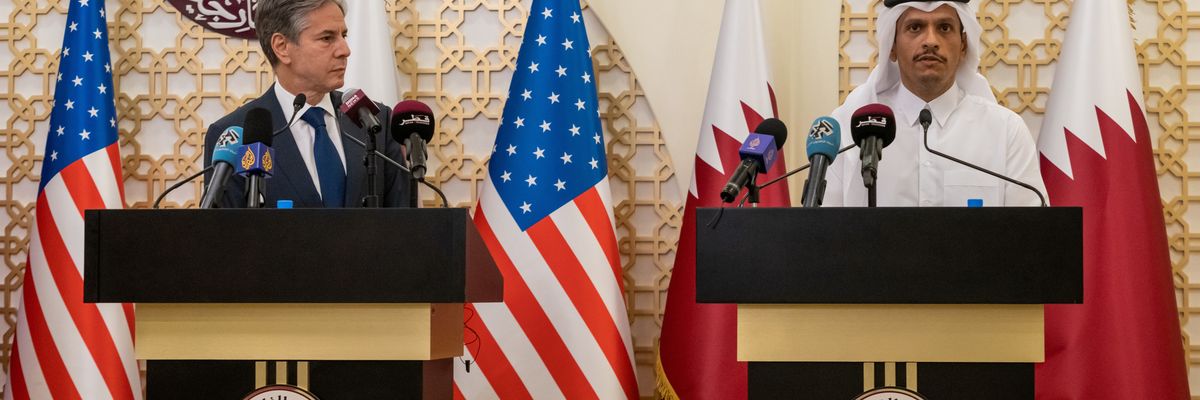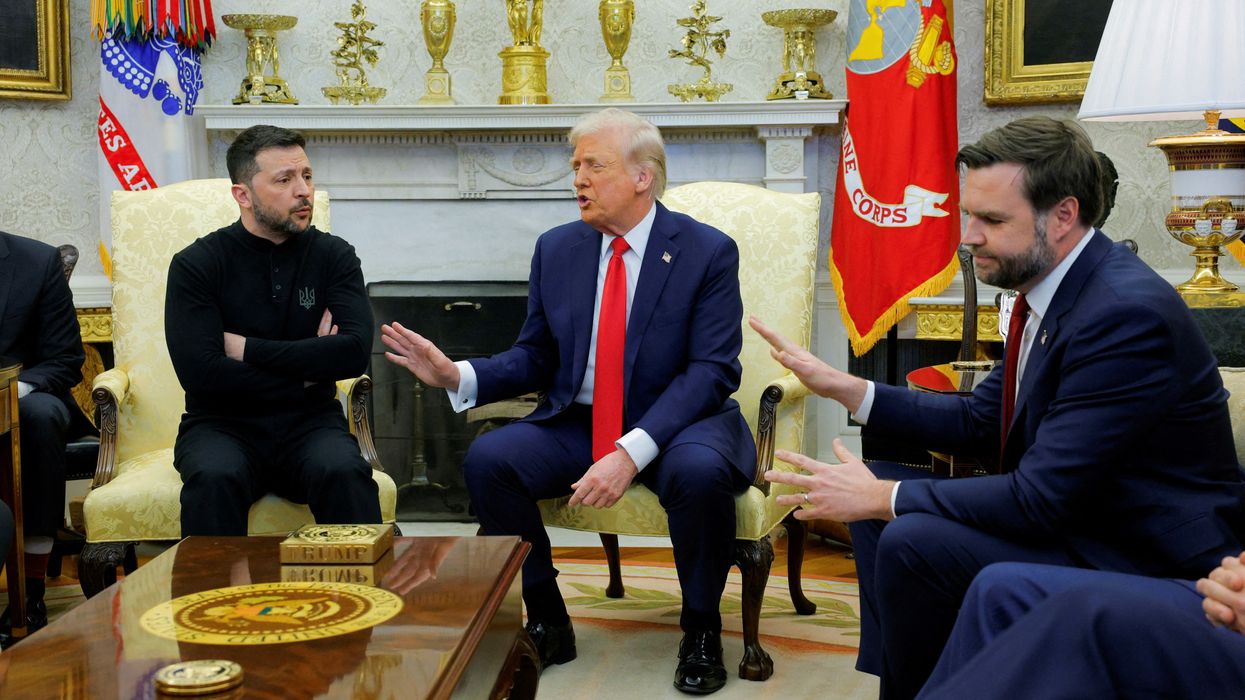This article has been republished with permission from Orient XXI.
In June 2017, the United Arab Emirates and Saudi Arabia led a small coalition of Arab states to embargo Qatar. Qatar appeared to be upon its nadir of regional influence. The tiny peninsular state faced isolation by the Emirati-Saudi counterrevolutionary axis, and its political investment into the Muslim Brotherhood had borne little fruit. It faced pressure to shut down its media sector, including the standard-bearer of Al-Jazeera. As the Emirati and Saudi leaderships basked in the glow of praise from the Trump administration, Qatar’s future looked uncertain.
More than four years later, the situation has dramatically reversed. The Gulf arena has witnessed a decisive reboot of its geopolitical balance. Qatar has redefined itself with a foreign policy that reaches well beyond its diminutive size. It is now the Emirates that finds itself on the defensive, having suffered blowback on multiple regional fronts. This new situation has resulted from a stark contrast in regional approaches. Qatar has deployed independent statecraft and over-the-horizon strategy, whereas the Emirates has been locked onto short-term tactics.
The Afghan file
The clearest sign of Qatar’s restoration comes from Afghanistan. While Qatar has long served as a mediator to regional conflicts, it controversially decided to host the Taliban in 2013 and later arbitrate peace talks. Now, in the aftermath of the American withdrawal, Qatar has become Afghanistan’s key power broker by virtue of being the Taliban’s most entrusted foreign interlocutor. It facilitated airlifts for innumerable Americans and at-risk Afghans, and alongside Turkey has agreed to operate Kabul’s airport on behalf of the Taliban. Relations between the West and Taliban now rely upon the decisions made by Doha.
This signals a critical shift in how Qatari interests are stretching beyond what its Gulf rivals have achieved. In the past, conflicts centered around the Gulf states and Iran inevitably boiled down to Middle East energy politics, and the security of local oil and gas reserves. Afghanistan is different. This is the battlefield that hosted two decades of Western interventionism against jihadism, harboring traumatic memories of terrorism and Islamism for Western powers. And it is here, far from the Strait of Hormuz, where Qatari influence has re-emerged.
The breakthrough in Afghanistan has now placed Qatar in a situation of sharp irony. Previously, the Qatari leadership was accused of cavorting with Islamism, and hence terrorism. Now, it serves as the primary conduit to the Taliban, and outside actors must rely upon Doha in order to monitor and attenuate its extremely conservative brand of Islamist ideology.
History foretells, however, that geopolitical twists in Central Asia do not end the “great game” so much as bring new players into its dynamics. Qatar must soon confront the influence of Pakistan, which has its own longer history of supporting the Taliban. Pakistan’s militarized involvement in Afghanistan dates back to the Cold War, when it sought greater strategic depth against India. It has also sought to thwart Pashtun nationalism at home by supporting an Islamist version of it on the other side of the Western border. Further engaging the Taliban now also would allow it to reshape the Taliban branches and madrasas operating within its own borders, which are fast growing in popularity.
As Qatar flexes its muscle in Afghanistan, it will not lose sight of more traditional and vital grounds within the Arab world. Palestine may be the next opening, where Qatar will seek to replicate its Afghan success by serving as an intermediary between Hamas, on the one hand, and the US and Israel on the other. Unlike the Emirates, Qatar still commands credibility among Palestinians by virtue of not normalizing relations with Israel. Unlike the rest of the counterrevolutionary axis, it can more honestly deal with Hamas because it has never declared the Islamist group as a terrorist actor.
In doing so, Qatar could alleviate the suffering of the Gazans without explicitly backing Hamas, and hence preserve its credibility with the US and Israel. The ultimate goal may be a grand bargain of sorts, one that facilitates contacts between the US, Israel, and the Palestinians.
A counterrevolutionary front accumulating errors
The converse side of Qatar’s strategic victory has been the tactical miscalculations of the UAE, and by extension the counterrevolutionary front. Qatari statecraft has relied upon soft power and the adroit use of independent diplomacy. By contrast, the Emirati-led approach after the Arab Spring leaned heavily on hard power. Under the aegis of the Trump administration’s complicity, it deployed military interventions to halt any democratic breakthrough in the region. It also promoted new technologies like Pegasus to pursue dissent and critical voices abroad.
However, such overreach has shown its limitations, not least because coercive manipulations have only amplified economic and social crises. The disastrous conditions in Libya and Yemen corroborate this highly uneven record. The Emiratis could not improve matters even in Palestine during the most recent Gaza war, for enthusiastically backing the “deal of the century” under the Trump administration proved toxic to its ability to engage Palestinians on the ground. Even the Saudi-Emirati embargo against Qatar flopped, as the reluctant reconciliation with Doha this past January proved.
It was not traditionally this way. Saudi Arabia and the UAE once mastered what the Qataris are now doing. Saudi Arabia previously enjoyed a special relationship in Yemen, in much the same way that Qatar has in Afghanistan now. Likewise, when the Taliban last ruled Afghanistan in the late 1990s, Saudi Arabia and the Emirates were the only Arab countries to recognize their governance. They developed networks that penetrated the country deeply. Yet these channels of access and influence wilted under the counterrevolutionary campaigns after the Arab Spring, as well as through the reification of rigid, hierarchical orders within their own states.
These tradeoffs have not yielded expected returns, because the counterrevolutionary axis never succeeded in crushing the spirit of democratic change and the will to participate across the region. The imperative to restore authoritarian stability stumbled as popular movements continued mobilizing over the past decade. The second wave of the Arab Spring throughout 2018-19 in Algeria, Sudan, Iraq, and Lebanon demonstrated an illuminating reality. While the counterrevolutionary front can obstruct democratic advances, it cannot turn back the clock and reimpose a past that has become painfully obsolete.
Another factor for Qatar’s re-emergence has been the waning coherence of the counterrevolutionary axis itself. In the immediate post-Arab Spring years, the Saudi and Emirati leaderships moved in lockstep, with their foreign policies harmonized in many areas. Recently under Crown Prince Mohammad bin Salman, however, Saudi Arabia has redefined its approach, and learned to act more pragmatically by taking more distance from the UAE.
The reasons for such discord are many. The Saudi regime has found itself too often serving as the unappreciated auxiliary to the Emirati leadership. Riyadh has expended enormous military resources to underwrite their counterrevolutionary expeditions, while withering under harsh human rights criticisms. Moreover, the Saudis were unnerved with the Emirati move to normalize ties with Israel, for they know they cannot follow suit. Not only is Saudi society far larger and domestic opposition far stronger, but its leadership also bears the symbolic burden of protecting the cradle of Islam.
Tensions with Saudi Arabia
Fundamentally, the Saudi regime fights for the same geopolitical market share as the Emirati leadership, and this competition has now burst into the open. Public disagreements between the two have become more flagrant, as in this summer’s rift over oil production that temporarily marginalized OPEC. This was also shown in the recent Saudi decision to halt doing business with any global firms that did not base their regional headquarters in Saudi Arabia.
Also favoring Qatar has been the rapprochement between Turkey and Egypt, which is unfolding amidst a new turn within the regional narrative of Islamism. This warming of relations shows that Erdoğan is willing to reduce Turkish support for the Muslim Brotherhood, which in turn has encouraged Qatar to do the same. Both recognize that establishment Islamist actors, such as the Brotherhood in Egypt, Ennahda in Tunisia, and the PJD in Morocco, are waning in stature.
To be sure, these are different groups operating in very distinctive environments. However, their current situations reveal a global trend: the dual failure to attract popular support on ideological grounds, while making institutional inroads into authoritarian states that remain wary of allowing Islamists to penetrate their structures. This does not mark the end of Islamism as a political force by any means, for there are still significant sectors of these societies willing to support its conservative platform combining faith with politics. However, this has nonetheless carved out new opportunities by removing Islamism as a point of contention between Doha and Riyadh, while untying Qatari hands to act more freely.
Changing rules of the game
That Qatar is resurgent through its foreign policy should not intimate any wild assumptions about its ideological commitments. Qatar does not promote liberalism, and it does not advocate another Arab Spring. Qatar is not part of the counterrevolution, but neither is it a revolutionary actor. It is a pragmatic actor that understands the direction of history.
Likewise, that the Emirates has stumbled should not diminish its domestic strengths. The UAE boasts of an effective state administration and high institutional capacities, which attracts an impressive spectrum of global firms and workers. Its energy reserves are considerable. Moreover, while its political system remains as closed as Saudi Arabia, it is less vulnerable to internal opposition and public protest given its smaller society and technology-driven methods of containment. Hence, its setbacks across the region will not necessarily translate into setbacks at home.
Nonetheless, Qatar’s strategic revival does herald pivotal implications for regional developments. First, now that the playing field between Qatar and the UAE has been leveled, both states will search for new ways to outmaneuver the other. Qatari statecraft, for instance, leverages educational, media, and cultural resources to broadcast influence in much the same way as the Emirates. Yet Qatar is still learning to do what the UAE has done—translate these intangible elements into profitable economic outcomes, such as through its proficiency in port management. The Emiratis have also invested into crucial economic sectors in other countries and gained access to vital resources abroad.
Second, the Emirates will bank on its relationship with China. Unlike the US, China’s presence in the Middle East relies upon economic agreements rather than military assets. Within the Gulf, the UAE has uniquely committed itself to Chinese entry into the region. For example, it has been a major hub in Beijing’s vaccine diplomacy, helping to both produce and distribute China’s COVID-19 vaccines to the rest of the Arab world. The next logical step lays in addressing Chinese interests in the Gulf as an outlet for its Belt and Road initiative, which will require more complex agreements regarding logistics, transportation, and supply chains.
In sum, two small Gulf states with outsized ambitions are beginning another round of geopolitical competition. The results may be as unpredictable as the last one.
















